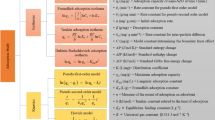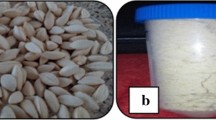Abstract
The use of cowpea pod (CPP) biomass for the removal of Pb(II) ions from aqueous solution was investigated. The effects of factors such as dosage concentration (0.2 to 1.6 g L−1), pH (2 to 8), contact time (5 to 120 min), metal ion concentrations (10 to 80 mg L−1) and temperature (20 to 50 °C) were examined through batch studies. The biosorption data conformed best to the Langmuir model at the three working temperatures (20, 30 and 40 °C) as revealed by the correlation coefficients (R 2) which were greater than 0.940. The maximum sorption capacity of the CPP for Pb(II) was 32.96 mg g−1 at 313 K. Furthermore, the kinetic data fitted well to the pseudo-second-order model as it had the lowest sum of square error (SSE) values and correlation coefficients close to unity (R 2 > 0.999). The thermodynamic parameters (ΔG°, ΔS° and ΔH°) showed that the biosorption process was spontaneous, feasible and endothermic. The results obtained in the present study indicated that cowpea pod biomass could be used for the effective removal of Pb(II) from aqueous solution.











Similar content being viewed by others
References
Bhatti, H., & Amin, M. (2013). Removal of zirconium(IV) from aqueous solution by Coriolus versicolor: equilibrium and thermodynamic study. Ecological Engineering, 51, 178–180.
Bhatti, H. N., & Hamid, S. (2013). Removal of uranium(VI) from aqueous solutions using Eucalyptus citriodora distillation sludge. International journal of Environmental Science and Technology, 11(3), 813–822. doi:10.1007/s13762-013-0267-3.
Chigondo, F., & Nyamunda, B. (2013). Removal of lead(II) and copper(II) ions from aqueous solution by baobab (Adononsia digitata) fruit shells biomass. IOSR Journal of Applied Chemistry, 5(1), 43–50 Retrieved from http://www.iosrjournals.org/iosr-jac/papers/vol5-issue1/G0514350.pdf.
Clark, A. (2007). Managing cover crops profitably. In Sustainable Agriculture Network (3 rd, pp. 125–129). Beltsville.
Dada, A. O., Ojediran, J. O., & Olalekan, A. P. (2013). Sorption of Pb2+ from aqueous solution unto modified rice husk: isotherms studies. Advances in Physical Chemistry, 2013, 1–6.
Davis, D.W., Oelke, E.A., Oplinger, E.S., Doll, J.D., Hanson, C.V., & Putnam, D.H. (1991). Cowpea. Alternative Field Crops Manual. University of Wisconsin-Extension, Cooperative Extension University of Minnesota: Center for Alternative Plant and Animal Products and the Minnesota Extension Service.
Duran, A., Soylak, M., & Tuncel, S. A. (2008). Poly(vinyl pyridine-poly ethylene glycol methacrylate-ethylene glycol dimethacrylate) beads for heavy metal removal. Journal of Hazardous Materials, 155(1–2), 114–120. doi:10.1016/j.jhazmat.2007.11.037.
Freundlich, H. M. (1906). Over the adsorption in solution. Journal of Physical Chemistry, 57, 384–470.
Geethamani, C. K., Ramesh, S. T., Gandhimathi, R., & Nidheesh, P. V. (2014). Alkali-treated fly ash for the removal of fluoride from aqueous solutions. Desalination and Water Treatment, 52, 19–21.
Gupta, V. K., Rastogi, A., & Nayak, A. (2010). Biosorption of nickel onto treated alga (Oedogonium hatei): application of isotherm and kinetic models. Journal of Colloid and Interface Science, 342(2), 533–539. doi:10.1016/j.jcis.2009.10.074.
Guyo, U., Mhonyera, J., & Moyo, M. (2014). Pb(II) adsorption from aqueous solutions by raw and treated biomass of maize stover—a comparative study. Process Safety and Environmental Protection, 93(June), 192–200. doi:10.1016/j.psep.2014.06.009.
Ho, Y. S., & McKay, G. (1999). Pseudo second order model for sorption processes. Process Biochemistry, 34, 451–465.
Ji, K., Kim, J., Lee, M., Park, S., Kwon, H. J., Cheong, H. K., Jang, J. Y., Kim, D. S., Yu, S., Kim, Y. W., Lee, K. Y., Yang, S. O., Jhung, I. J., Young, W. O., Paek, D. H., Hong, Y. C., & Choi, K. (2013). Assessment of exposure to heavy metals and health risks among residents near abandoned metal mines in Goseong, Korea. Environmental Pollution (Barking, Essex : 1987), 178, 322–328. doi:10.1016/j.envpol.2013.03.031.
Kanu, S. A., Moyo, M., Khamlich, S., & Jonathan, O. (2015). Adsorption of cadmium from aqueous solution using rooibos shoots as adsorbent. Toxicological & Environmental Chemistry, (April), 37–41. doi:10.1080/02772248.2015.1030666.
Kausar, A., Bhatti, H. N., & MacKinnon, G. (2013). Equilibrium, kinetic and thermodynamic studies on the removal of U(VI) by low cost agricultural waste. Colloids and surfaces. B, Biointerfaces, 111, 124–133. doi:10.1016/j.colsurfb.2013.05.028.
Kelly-Vargas, K., Cerro-Lopez, M., Reyna-Tellez, S., Bandala, E. R., & Sanchez-Salas, J. L. (2012). Biosorption of heavy metals in polluted water, using different waste fruit cortex. Physics and Chemistry of the Earth, Parts A/B/C, 37-39, 26–29. doi:10.1016/j.pce.2011.03.006.
Lagergren, S. (1898). About the theory of so-called adsorption of soluble substances. Kungliga Svenska Vetenskapsakademiens Handlingar, 24(4), 1–39.
Langmuir, I. (1918). The adsorption of gases on plane surfaces of glass, mica and platinum. Journal of the American Chemical Society, 40, 1361–1403.
Meena, A. K., Mishra, G. K., Rai, P. K., Rajagopal, C., & Nagar, P. N. (2005). Removal of heavy metal ions from aqueous solutions using carbon aerogel as an adsorbent. Journal of Hazardous Materials, 122(1–2), 161–170. doi:10.1016/j.jhazmat.2005.03.024.
Moyo, M., Chikazaza, L., Nyamunda, B. C., & Guyo, U. (2013). Adsorption batch studies on the removal of Pb(II) using maize tassel based activated carbon. Journal of Chemistry, 2013.
Moyo, M., Guyo, U., Mawenyiyo, G., Zinyama, N. P., & Nyamunda, B. C. (2015b). Marula seed husk (Sclerocarya birrea) biomass as a low cost biosorbent for removal of Pb(II) and Cu(II) from aqueous solution. Journal of Industrial and Engineering Chemistry, 27, 126–132. doi:10.1016/j.jiec.2014.12.026.
Moyo, M., Sikwila, T. L., Sebata, E., Nyamunda, B. C., & Guyo, U. (2015a). Equilibrium, kinetic, and thermodynamic studies on biosorption of Cd(II) from aqueous solution by biochar. Research on Chemical Intermediates. doi:10.1007/s11164-015-2089-z.
Muhammad, N. Z., Raziya, N., & Muhammad, A. H. (2007). Biosorption of nickel from protonated rice bran. Journal of Hazardous Materials, 143, 478–485.
Nath, K., Panchani, S., Bhakhar, M. S., & Chatrola, S. (2013). Preparation of activated carbon from dried pods of Prosopis cineraria with zinc chloride activation for the removal of phenol. Environmental Science and Pollution Research, 20(6), 4030–4045.
Nharingo, T., Ziwurawa, M., & Guyo, U. (2015). Exploring the use of cactus Opuntia Ficus Indica in the biocoagulation–flocculation of Pb(II) ions from wastewaters. Journal of Environmental Science and Technology. doi:10.1007/s13762-015-0815-0.
Obregón-Valencia, D., & del Sun-Kou, M. R. (2014). Comparative cadmium adsorption study on activated carbon prepared from aguaje (Mauritia flexuosa) and olive fruit stones (Olea europaea L.). Journal of Environmental Chemical Engineering, 2(4), 2280–2288. doi:10.1016/j.jece.2014.10.004.
Rao, C. N., Subbarayudu, K., Vijaya, Y., & Venkata Subbaiah, M. (2014). Adsorption of Ni(II) from aqueous solution by activated carbons derived from tobacco stem adsorption of Ni(II) from aqueous solution by activated carbons derived from tobacco stem. Desalination and Water Treatment, 1–8. doi:10.1080/19443994.2014.910837.
Saleem, M., Wongsrisujarit, N., & Boonyarattanakalin, S. (2015). Removal of nickel(II) ion by adsorption on coconut copra meal biosorbent. Desalination and Water Treatment, 1–13. doi:10.1080/19443994.2015.1005155.
Salehi, P., Tajabadi, F. M., Younesi, H., & Dashti, Y. (2014). Optimization of lead and nickel biosorption by Cystoseira trinodis (brown algae) using response surface methodology. Clean - Soil, Air, Water, 42(3), 243–250. doi:10.1002/clen.201100429.
Sari, A., Mendil, D., Tuzen, M., & Soylak, M. (2008). Biosorption of Cd(II) and Cr(III) from aqueous solution by moss (Hylocomium splendens) biomass: equilibrium, kinetic and thermodynamic studies. Chemical Engineering Journal, 144(1), 1–9. doi:10.1016/j.cej.2007.12.020.
Sari, A., & Tuzen, M. (2008). Biosorption of total chromium from aqueous solution by red algae (Ceramium virgatum): equilibrium, kinetic and thermodynamic studies. Journal of Hazardous Materials, 160(2–3), 349–355. doi:10.1016/j.jhazmat.2008.03.005.
Wang, L., Zhang, J., Zhao, R., Li, Y., Li, C., & Zhang, C. (2010). Adsorption of Pb(II) on activated carbon prepared from Polygonum orientale Linn.: kinetics, isotherms, pH, and ionic strength studies. Bioresource Technology, 101(15), 5808–5814. doi:10.1016/j.biortech.2010.02.099.
Wong, K. K., Lee, C. K., Low, K. S., & Haron, M. J. (2003). Removal of Cu and Pb by tartaric acid modfied rice husk from aqueous solution. Chemosphere, 50, 23–28.
World Health Organisation (2006). Guidelines for Drinking-water Quality (Vol. 1).
Xu, P., Zeng, G. M., Huang, D. L., Feng, C. L., Hu, S., Zhao, M. H., Lai, C., Wei, Z., Huang, C., Xie, G. X., & Liu, Z. F. (2012). Use of iron oxide nanomaterials in wastewater treatment: a review. The Science of the Total Environment, 424, 1–10. doi:10.1016/j.scitotenv.2012.02.023.
Yuvaraja, G., Krishnaiah, N., Subbaiah, M. V., & Krishnaiah, A. (2014). Biosorption of Pb(II) from aqueous solution by Solanum melongena leaf powder as a low-cost biosorbent prepared from agricultural waste. Colloids and Surfaces B: Biointerfaces, 114, 75–81.
Zvinowanda, C. M., Okonkwo, J. O., Sekhula, M. M., Agyei, N. M., & Sadiku, R. (2009). Application of maize tassel for the removal of Pb, Se, Sr, U and V from borehole water contaminated with mine wastewater in the presence of alkaline metals. Journal of Hazardous Materials, 164(2–3), 884–891. doi:10.1016/j.jhazmat.2008.08.110.
Acknowledgements
The authors greatly appreciate the Midlands State University Research Board for funding the research.
Author information
Authors and Affiliations
Corresponding author
Rights and permissions
About this article
Cite this article
Guyo, U., Moyo, M. Cowpea pod (Vigna unguiculata) biomass as a low-cost biosorbent for removal of Pb(II) ions from aqueous solution. Environ Monit Assess 189, 47 (2017). https://doi.org/10.1007/s10661-016-5728-y
Received:
Accepted:
Published:
DOI: https://doi.org/10.1007/s10661-016-5728-y




